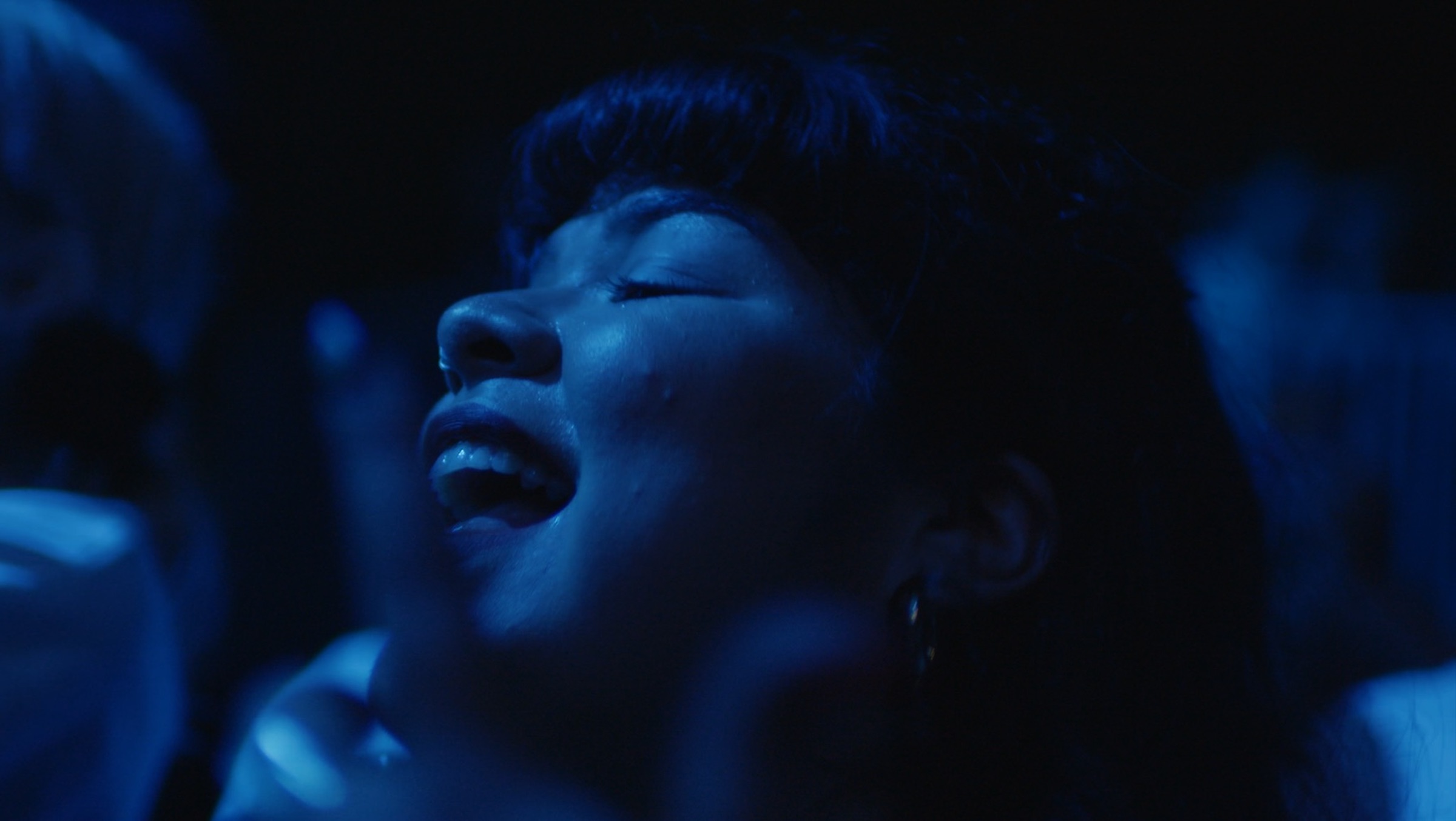The singer Jacks Haupt appears onscreen dressed like a vampire: gothic, glamorous, sultry. She wears her black hair long and wavy, eyeliner winged, lips glossed, earrings dangling—with fake fangs carefully glued onto her canines.
Scenes flash by: Haupt delicately spraying herself with a perfume atomizer, lunging toward the camera and biting, fanning herself with a scarlet hand fan, praying with an oversized black and gold crucifix, and singing—dressed in a black latex cloak—from the backseat of a moving convertible.
This montage comes from the documentary Mija—which had been scheduled to premiere on Disney+ on Friday but has been pushed to an unspecified date in the future. The footage, however, is borrowed from the music video for one of Haupt’s first songs, “3am,” which she wrote when she was 17. Since then, she’s self-released two EPs (1973 and La Mezcla: Ilusion, both in 2020 and infused with R&B and soul) and an assortment of singles.
“You wanna take me out/ in your little coche,” Haupt croons in Spanglish in the chorus. “En medio de la noche/ we’re out till the sun sets.”
Mija tells the tale of Doris Muñoz, a then-music manager in her mid-20s who made it big by managing indie musician Cuco. When Covid hits, though, Muñoz and Cuco stop working together and Muñoz begins to scout out her next artist. Enter Haupt. Both women are the first American-born members of their undocumented Mexican families.
Isabel Castro, the creator and director of Mija, is a Mexican immigrant herself. As a filmmaker and multimedia journalist, Castro has worked closely with immigration and all of the heavy issues it entails—from the fight to prove that humanitarian aid is not a crime with USA v Scott to a family’s struggle to reunite after being divided by immigration authorities in Darlin. With Mija, Castro strove to showcase joy and radical imagination: What kind of futures could the children of immigrants create for themselves and their families—even and especially in the world of music?

A striver seeks her big break
Haupt, 22, hails from the Oak Cliff neighborhood of Dallas, Texas, where lowriders cruise down Jefferson Boulevard, drivers in oversized Dallas Cowboys jerseys with their sunglasses pushed back. Her music draws from the Chicano community of Texas, the divine feminine, and influences ranging from Amy Winehouse and Thom Yorke of Radiohead to Latin soul musician Joe Bataan and the English electronic band Sneaker Pimps. It was in Oak Cliff that the musician wrote “3am,” a song released the day after she graduated from high school.
“3am”—inspired by both her high school crush and her grandparents’ love story—marked a turning point for Haupt: It was the first song that made her feel like an artist. Back then, she was relying on her phone to make music, using apps like GarageBand and BandLab.
“It’s such a memorable time for me, because it was a struggling process at the very beginning,” Haupt says in a recent phone call. “I was releasing stuff on SoundCloud, I was making stuff through my phone, because I could not afford to get on studio sessions at all.”
Midway through the documentary, Haupt boards a plane for the first time to fly from Dallas to Los Angeles, meet Muñoz, and work at the Cosmica Artists + Records recording studio in Boyle Heights.
“Everything you’ve ever heard, she recorded on her iPhone,” Muñoz tells Gil Gastelum, the CEO and founder of the record label. “That’s amazing,” Gastelum responds, turning toward Haupt. “There’s a reason why we’re all here, excited to meet you: Because we believe in what you’re doing.”
Perhaps Haupt’s biggest believer is her maternal grandfather, who once harbored dreams of becoming a musician himself. He would babysit Haupt, her siblings, and her cousins growing up, and play them the ‘60s and ‘70s rock and Chicano soul that inspired Haupt’s earlier music.
“I was 14, playing keys at my aunt’s place,” Haupt says. “And he was like, ‘I got you this keyboard. I hope you pursue whatever you’re doing.’ And in Spanish he’d be like, ‘Échale ganas, pues.’”
A filmmaker finds the perfect subjects
Castro stumbled upon Haupt through sheer serendipity. Castro comes from a television producing background, where the work done behind the scenes can go misunderstood or unseen—much like the work of a music manager. So she naturally gravitated toward Muñoz—who she came across in a California Sunday article about Cuco’s rise— as a subject.

Through Muñoz, she met Haupt. Castro saw in Haupt an innate ability to coexist with the camera, a skill gleaned from documenting her own life on film and social media and through the music videos she made with her friends.
“I think what was so beautiful about Jacks—and I think it’s reflected in her music, too—” Castro says, “is that there’s really an inherent ability to talk in a very vulnerable way.”
In her work as a journalist, Castro has covered countless immigration stories from both sides of the U.S.-Mexico border. Sometimes, she says, she feels rage around immigration policy in the U.S. In each story she works on, she tries to understand the trauma surrounding these narratives and show the world how it affects people on a human level.
“I think that the real trauma and grief of these experiences is present too, but on a day-to-day level, some of these other emotions are just as present—and sometimes more present,” Castro says. “I feel like the real hurt and the pain, we carry it with us, but sometimes it’s actually harder to access that.”
A different kind of immigrant story
With Mija, Castro was craving an approach that didn’t exclusively focus on trauma, but rather leaned into a nuanced blend of emotions like guilt and resentment and joy. In the first scene of the documentary, Muñoz is working with Cuco at an event in Central Park called Selena for Sanctuary, a Selena-themed outdoor concert in support of immigration rights.
“In this film, it was really intentional to include joy, include humor,” Castro said. “When you’re in a crowd, listening to Selena covers, listening to Cuco sing in Spanish, there’s just a such a sense of pride and joy and hope that I wanted to live in as well.”
Toward the end of the film, Muñoz and Haupt are driving together through midnight Los Angeles in a convertible—Muñoz in the driver’s seat, Haupt gazing around in wonder from the backseat. Castro dabbles in the space between journalism and art, which is deeply apparent here: It feels like a dream sequence.
“They say you can’t dream of a new face,” Muñoz narrates. The faces that appear while you’re sleeping are the ones you’ve seen before.”
“When you’ve never seen someone like you succeed, it feels impossible,” she continues. “Jacks is a reminder que todos tenemos el derecho de brillar, de soñar.”
“Jacks is a reminder that we all have the right to shine, to dream.”
More Must-Reads from TIME
- Why Trump’s Message Worked on Latino Men
- What Trump’s Win Could Mean for Housing
- The 100 Must-Read Books of 2024
- Sleep Doctors Share the 1 Tip That’s Changed Their Lives
- Column: Let’s Bring Back Romance
- What It’s Like to Have Long COVID As a Kid
- FX’s Say Nothing Is the Must-Watch Political Thriller of 2024
- Merle Bombardieri Is Helping People Make the Baby Decision
Contact us at letters@time.com